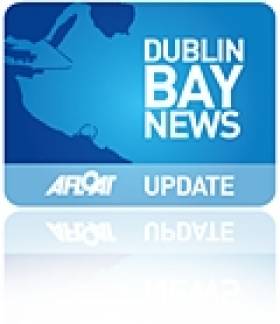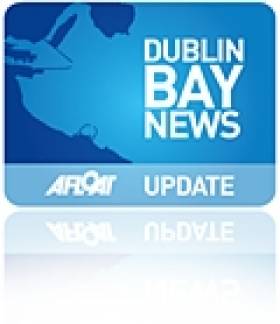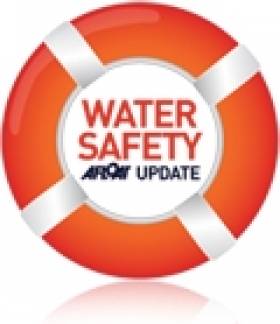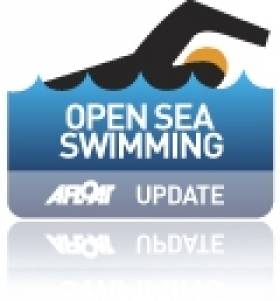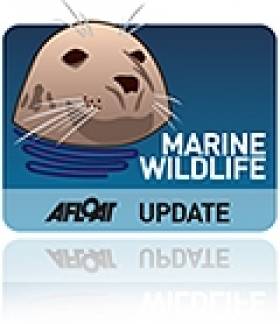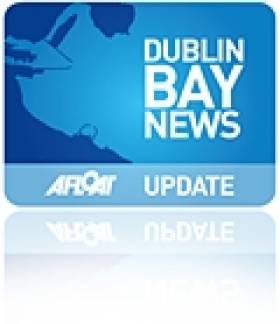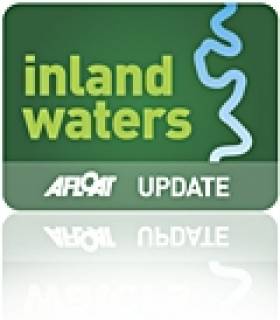Displaying items by tag: swimming
#DublinBay - Following our previous story on the swimming ban at four South Dublin beaches due to high levels of E.coli and other bacteria in water samples earlier this week, Dun Laoghaire-Rathdown County Council announced on its Twitter account this afternoon that it was lifting its prohibition notices from the beaches at White Rock in Dalkey and Killiney, with the latter also seeing its Blue Flag raised again.
Results from tests at Sandymount were also clear, but as RTÉ News reports, emergency overflow into Dublin Bay from the city drainage network as a result of this morning's heavy rainfall has seen that beach's temporary swimming ban replaced with a 'Bathing Water Advisory Notice', with further tests to be carried out this evening.
#DublinBay - Four bathing spots in South Dublin have been temporarily closed to swimmers after water tests indicated levels of bacteria above the minimum health standards.
As TheJournal.ie reports, Killiney Beach will have its Blue Flag status suspended by Dun Laoghaire-Rathdown County Council pending the investigation into the high levels of E.coli and Enterococci detected in water samples taken yesterday (16 July).
The popular White Rock beach in nearby Dalkey has also been closed to bathers, while Dublin City Council has prohibited swimming at Sandymount Strand and the South Wall after its own water quality tests.
Waters at all four Dublin Bay locations have been resampled with results due tomorrow (Friday 18 July).
Teens Hospitalised After Swimming Accident
#WaterSafety - After yesterday's warning against taking risks on or near the water during the current hot spell comes news that three teenagers have been hospitalised after an accident at a lake near an apartment complex in Blanchardstown yesterday evening (20 June).
TheJournal.ie reports that a boy and two girls, all aged around 13, were rushed to Temple Street Children's Hospital after the swimming accident. As of last night the boy was said to be in critical condition.
Update 11am: RTÉ News is now reporting that the 13-year-old boy has died in hospital.
Elsewhere in Dublin, another swimming incident on Thursday 19 June saw two men rescued from a cliffside at Balscadden Bay in Howth after getting into difficulty, according to Independent.ie.
The duo struggled to swim against the strong current and eventually made it to rocks at the cliff base, but one of the men was too exhausted to continue.
They were only rescued after attracting the attention of passers-by, tourists who alerted staff at a nearby café.
Sea Jumpers Taking A Big Risk During Hot Spell
#WaterSafety - Despite Irish Water Safety's sensible advice for open sea swimming and inland water bathing during the current hot spell, some reckless souls have been taking their lives in their hands with some scary jumps into the drink.
The video above from Independent.ie shows youths leaping from a rusted old derrick into the Grand Canal as it joins the River Liffey in Dublin's Docklands.
And such dangerous dives have been echoed elsewhere, with popular spots from Howth to Dalkey springing up on social media as young people Instagram their seaside adventures. SEE BELOW FOR MORE
One place where no one's doing any diving or swimming right now is Bettystown Beach - where people have been warned away by Meath County Council over elevated levels of Ecoli and other bacteria detected in the water this week, according to TheJournal.ie.
In any case, best leave the diving to the professionals - specifically the competitors in the returning Red Bull Cliff Diving World Series.
The Meath Chronicle has the full list of elite divers who will descend on Inis Mór next weekend, including last year's winner Artem Silchenko and cliff diving legend Orlando Duque.
Rounding up some of the craziness... Robin Blandford posted this image of young people leaping from the Baily cliffs at Howth into unknown waters below:
These kids at Bullock Harbour in Dalkey were also taking a big chance jumping in so high above the water and so close to the rocks:
Perhaps they should take a leaf out of this chap's book and take the plunge from a more sensible height (provided bathing isn't prohibited, of course):
Open Sea Swimming Advice Issued by Irish Water Safety
#watersafety – Irish Water Safety is appealing to the public to stay within their depth when swimming in open water during this current spell of hot weather, following an analysis of the thirteen drownings in last years heat wave.
Swim at Lifeguarded waterways - here
If there is no Lifeguarded waterway nearby then swim at a recognized, traditional bathing area
Swim within your depth - stay within your depth;
Use local knowledge to determine local hazards and safest areas to swim;
Ensure that ringbuoys are present;
Make sure that the edges are shallow shelving so that you can safely and easily enter and exit the water;
Only drink alcohol after your aquatic activity has ended. Stay Away From The Edge after you consume alcohol.
Never bring inflatable toys or floating killers to beaches, lakes or rivers
The majority of drownings, 62%, occur inland where river and lake beds can be difficult to see and therefore extremely difficult to determine if you are swimming within your depth. The onset of cramp, combined with the panicked realisation that you are out of your depth can have tragic consequences and be compounded further by the muscle cooling effect of longer periods in open water. Bear in mind that in a recent analysis on drowning over the last 25 years we discovered that 32% of drowning victims had consumed alcohol so stay away from water when you have been drinking.
If you see someone in difficulty, these simple steps may save a life:
Shout to the casualty and encourage them to shore. This may orientate them just enough.
Reach out with a long object such a branch or a piece of clothing but do not enter the water yourself.
Throw a ringbuoy or any floating object and call 112 for the coast guard.
Dublin Bay Gets Nod As Ironman Triathlon Returns To Ireland
#Ironman - The Ironman 70.3 triathlon is set to make its return to Ireland next year as The Irish Times reports Dublin will stage a date of the 31-stop series in August 2015.
Previously the athletic challenge was held in Galway in August 2011 and again the following year, when more than 2,000 participants blew away local swimming ban concerns to swim 1.9km along Salthill promenad before a 90km cycle through Connemara and a 21.1km run through the streets of Galway's old-town Claddagh district.
But funding issues resulted in its cancellation last year, despite some 1,600 people having registered to take part eight months in advance.
However, Galway's loss is the capital's gain, and Dublin will play host to an expected 3,000 triathletes swimming in Dublin Bay, cycling through the Wicklow Mountains and running through the city centre's thoroughfares.
And that's not all, as outgoing Dublin Lord Mayor Oisín Quinn also announced that Dublin will see a full-distance triathlon in 2016. The Irish Times has more on the story HERE.
Dolphins Guard Oceans7 Swimmer From Shark
#MarineWildlife - British long-distance swimmer Adam Walker has told of his lucky escape from a shark attack thanks to a protective pod of dolphins.
As the Irish Examiner reports, Walker was swimming 26km across the Cook Strait between New Zealand's main islands last week after spotting a shark on his tail.
But what happened next was even more remarkable, as he soon found himself surrounded by the cetacean bodyguards "protecting me and guiding me home".
Walker's swim of the Cook Strait was the penultimate stage in his attempt to be the first Briton to complete the Oceans7 Challenge, the open sea swimming equivalent of climbing the world's seven highest peaks.
He only has the Irish Channel left to swim to attain the accolade first claimed by West Cork endurance swimmer Steve Redmond two years ago.
'Swim For Pádraig' Group Races Round Ireland's Coastal Counties
#Swimming - Some 50 friends of a young German-Irish man in a coma since a road accident in the US last year are this weekend racing to swim all 17 Irish coastal counties over 38 hours for his recovery, as TheJournal.ie reports.
The 'Swim for Pádraig' was organised to raise funds for the care of popular 23-year-old Pádraig Schaler, who's currently in hospital in Germany after he was knocked off his bicycle in Cape Cod last summer while on a J1 working holiday.
Starting yesterday, the group aimed to pay tribute to their friend's swimming skills - and passion for the Irish language - by taking to the open water in every Irish coastal county.
And as of yesterday they had raised more than €22,000 for his treatment.
TheJournal.ie has much more on the story HERE.
Forty Foot Swimming Club Lifts Its Ban On Women
#FortyFoot - It's a big victory for women at the famous Forty Foot swimming spot in South Dublin as the adjacent - and formerly staunchly male-only - Sandycove Bathers' Association has decided to accept female members.
The move follows more than a year after the club's last vote on the motion to accept women members saw it rejected by 24 to 17, as previously reported on Afloat.ie.
According to The Irish Times, reform at the Sandycove club comes almost four decades after the ban on women bathing at the celebrated Dublin Bay dipping location - enshrined in the pages of James Joyce's Ulysses - was lifted in the wake of protests by the then burgeoning women's liberation movement.
It appears that a recent meeting at a local pub was all it took for the club to change its position on the matter - possibly prompted by the opening of a new council-built bathing shelter that's open to all.
The Irish Times has more on the story HERE.
NI Man Strong-Arms His Way Across Lough Neagh In Swim First
#LoughNeagh - Former British Army corporal Dean Owen recently swam 20 miles across Lough Neagh despite not having full use of his legs.
And as the News Letter reports, the achievement is doubly special as the route from the north-east shore to the south-west has never been completed before by any swimmer - let alone one only using their arms.
Owen - who broke his back in a road accident more than 10 years ago - received a plaque from Craigavon mayor Mark Baxter on top of the £8,500 (€10,000) he has already raised toward treatment for four-year-old Caleb Kerr's cerebral palsy.
In other Northern Ireland waterways news, residents of East Belfast will soon be able to enjoy a new crossing of the Connswater River at Victoria Park, according to the News Letter.
The Sam Thompson Bridge saw its main 60-tonne structure lifted into place by one of Europe's largest cranes last weekend.
It's expected to form part of a new network of pedestrian paths linking the Castlereagh Hills to Belfast Lough.


























